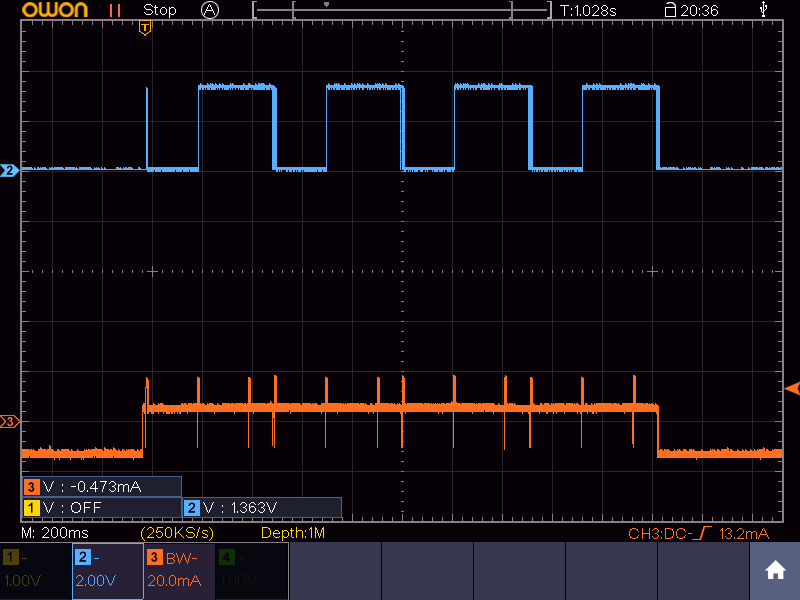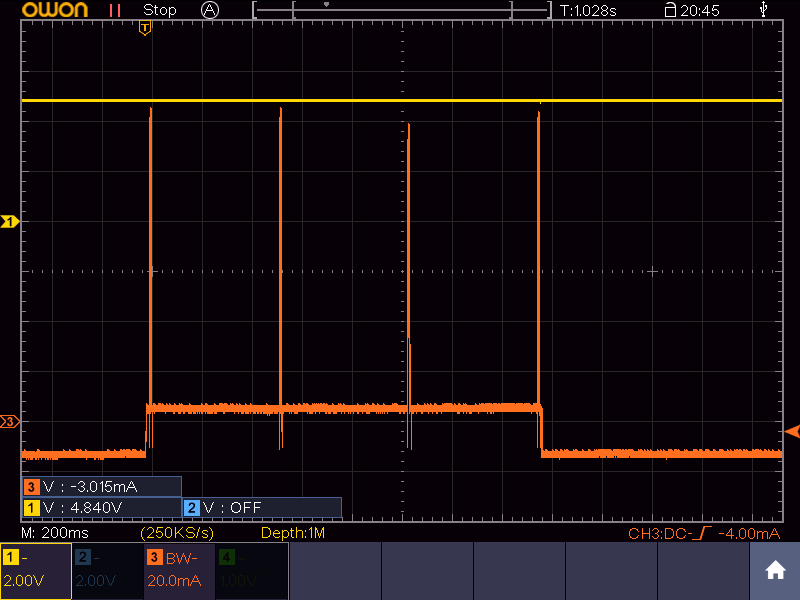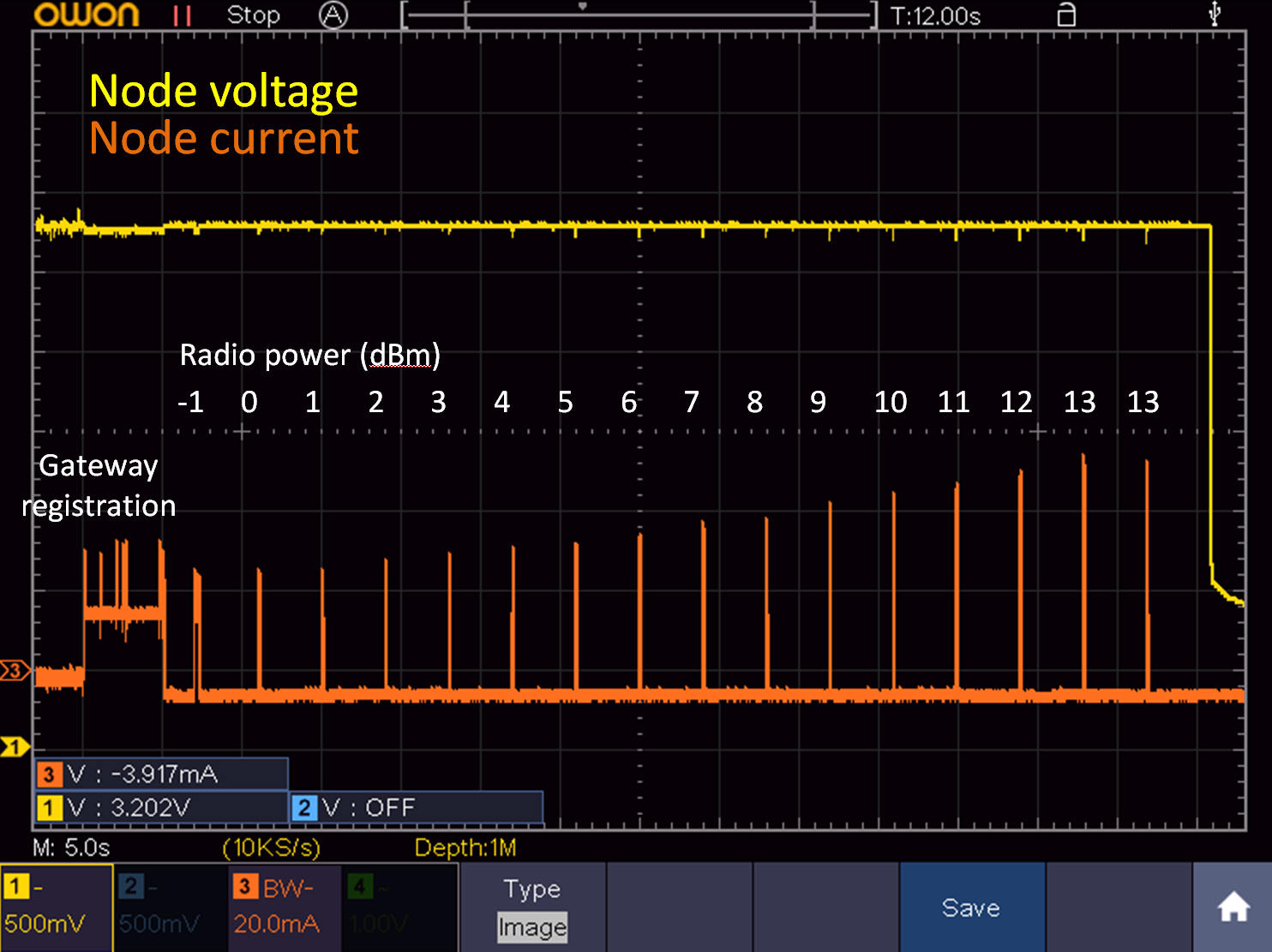RFM69 ATC not working?
-
@mfalkvidd
My code now looks pretty much the same as yours, except for the OTA stuff. But I don't see gateway messages in Domoticz. The node shows up with all its measurements.#define MY_DEBUG_VERBOSE_GATEWAY #include <MySensors.h> MyMessage msgRSSI(1,V_LEVEL); #define ARDUINO 100 // This space is intended to be used to include arduino libraries #undef ARDUINO void setup() { // Setup locally attached sensors } void presentation() { // Present locally attached sensors here present(1,S_SOUND); } void loop() { // Send locally attached sensors data here } void receive(const MyMessage &message) { int16_t rssiReceive = RFM69_getReceivingRSSI(); if (message.sender == 1 ) { send(msgRSSI.set(rssiReceive,0)); } }Is the gateway supposed to show up as a measurement? Any idea why that doesn't happen?
-
This is how I monitor RSSI and power % from the node: sending RSSI should be close to the RSSI target value set in the config file. I left atc enabled and if I move the node away from the gateway I see the power % going up while RSSI value stays more or less the same.
#ifdef MY_RADIO_RFM69 rssi = RFM69_getSendingRSSI(); // read RSSI in RFM69. Measure reception signal from gw send(msgRSSI1.set(rssi)); // send RSSI level wait(500); // wait to get idle rssi = RFM69_getReceivingRSSI(); // read RSSI in RFM69. Wait and measure background noise send(msgRSSI2.set(rssi)); // send RSSI level wait(200); // wait for next send PwrPcnt = RFM69_getTxPowerPercent(); // read TX Power in RFM69 send(msgPWR.set(PwrPcnt)); // send TX Power #endif -
it works the same, of course if you have a HW version you will see TX power % lower compared to a W module. I am not using those functions on the gateway because they are actually more node related
@gohan @mfalkvidd
I think it is related to the Raspberry Pi implementation of MySensors. If I use an Arduino/RFM69 gateway, the RSSI is as expected. At close range, the power drops to the minimum possible level and the RSSI is strong. I noticed that the interrupt pin is toggled during communication, see picture below (orange is node current, blue is gateway interrupt).

If I use the Raspberry gateway (with origin/development-3.0.0 MySensors), I get the following result (orange is node current, yellow is gateway interrupt). The same result is obtained with MySensors 2.3.0 (origin/master). I couldn't get the origin/development version to compile. It gives an error about MY_DEBUGDEVICE.

Apart from the much higher node current (and worse RSSI), the interrupt pin is always high and not toggled.Are you guys using a Raspberry gateway, or an Arduino gateway?
I haven't had time to dig into to the MySensors code further, but does any of you know if this could be the problem?
-
@gohan @mfalkvidd
I think it is related to the Raspberry Pi implementation of MySensors. If I use an Arduino/RFM69 gateway, the RSSI is as expected. At close range, the power drops to the minimum possible level and the RSSI is strong. I noticed that the interrupt pin is toggled during communication, see picture below (orange is node current, blue is gateway interrupt).

If I use the Raspberry gateway (with origin/development-3.0.0 MySensors), I get the following result (orange is node current, yellow is gateway interrupt). The same result is obtained with MySensors 2.3.0 (origin/master). I couldn't get the origin/development version to compile. It gives an error about MY_DEBUGDEVICE.

Apart from the much higher node current (and worse RSSI), the interrupt pin is always high and not toggled.Are you guys using a Raspberry gateway, or an Arduino gateway?
I haven't had time to dig into to the MySensors code further, but does any of you know if this could be the problem?
-
@gohan
I just tried with the node on MySensors 2.2.0, but I get the same result. I cannot get the gateway to compile with 2.2.0, I get the following errors:In file included from ./MySensors.h:49:0, from examples_linux/mysgw.cpp:83: ./drivers/RFM69/new/RFM69_new.cpp: In function ‘bool RFM69_initialise(uint32_t)’: ./MyConfig.h:716:26: error: ‘DEFAULT_RFM69_IRQ_NUM’ was not declared in this scope #define MY_RFM69_IRQ_NUM DEFAULT_RFM69_IRQ_NUM ^ ./drivers/RFM69/new/RFM69_new.cpp:230:18: note: in expansion of macro ‘MY_RFM69_IRQ_NUM’ attachInterrupt(MY_RFM69_IRQ_NUM, RFM69_interruptHandler, RISING); ^~~~~~~~~~~~~~~~ In file included from ./MySensors.h:347:0, from examples_linux/mysgw.cpp:83: ./hal/transport/MyTransportRFM69.cpp: In function ‘uint8_t transportReceive(void*)’: ./hal/transport/MyTransportRFM69.cpp:80:54: error: ‘RFM69_recv’ was not declared in this scope return RFM69_recv((uint8_t*)data, MAX_MESSAGE_LENGTH); ^ In file included from ./MySensors.h:343:0, from examples_linux/mysgw.cpp:83: ./drivers/RFM69/new/RFM69_new.cpp: At global scope: ./drivers/RFM69/new/RFM69_new.cpp:749:12: warning: ‘void RFM69_encrypt(const char*)’ defined but not used [-Wunused-function] LOCAL void RFM69_encrypt(const char *key) ^~~~~~~~~~~~~ ./drivers/RFM69/new/RFM69_new.cpp:599:12: warning: ‘void RFM69_ATCmode(bool, int16_t)’ defined but not used [-Wunused-function] LOCAL void RFM69_ATCmode(const bool onOff, const int16_t targetRSSI) ^~~~~~~~~~~~~ ./drivers/RFM69/new/RFM69_new.cpp:340:15: warning: ‘uint8_t RFM69_receive(uint8_t*, uint8_t)’ defined but not used [-Wunused-function] LOCAL uint8_t RFM69_receive(uint8_t *buf, const uint8_t maxBufSize)Do you have the gateway running with 2.2.0? And ATC works for the RFM69?
-
@mfalkvidd
And if you turn on ATC? Does that work? Are you on 2.3.0? -
@mfalkvidd
And if you turn on ATC? Does that work? Are you on 2.3.0? -
-
@gohan
I couldn't get the RSSI measurement on the gateway to work, so I'm not doing that.I want to get ATC to work. As ATC uses RSSI to optimize power, a correct RSSI measurement (on the node) is needed. ATC (and so the RSSI measurement) works well on an Arduino gateway, but not on a RPi.
As I don't have a software background and am still newish to MySensors, I'm hoping someone on the forum knows what to do. In the meantime, I'll keep digging myself :)
-
Was there any follow up to this issue?
I can confirm that ATC does not work using Rpi gateway. Well, it kind of works when you set very low MY_RFM69_ATC_TARGET_RSSI_DBM. I tried -100dBm and then the node is finally decreasing TX power to -2dbm. Anyway, when using Rpi as a gateway I can see (from node perspective) very low (-90) TX RSSI, whereas the same parameter is -26 when using arduino serial gateway (with the same close distance between node and the gateway).
Since the TX RSSI is very low, then the ATC works only when you set your target to lower than that, like mine -100 setting for test purposes.

